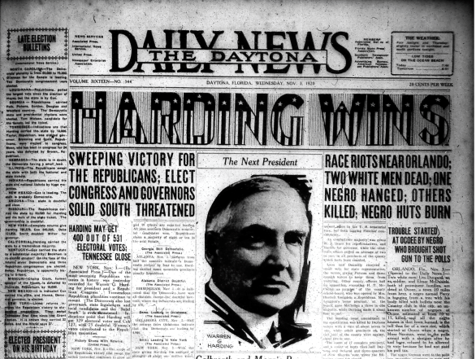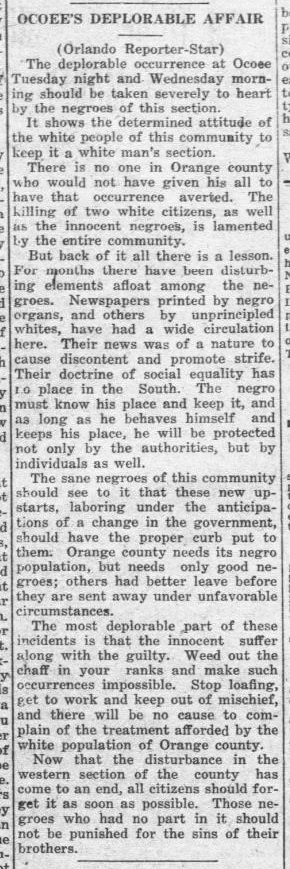Chapter 6: Newspaper Coverage of Ocoee
The largest word in the newspaper headline-cloud of U.S. newspapers that included accounts of the Ocoee Massacre is Negro. This indicates that Negro was the most-frequently-used word in newspaper reports. The hyper-use of Negro served at least two functions as description and as explanation. The over-use of the word indicated the location of the “riot” and assigned responsibility for causing the racial disturbance to Black Ocoee residents. Press accounts did not incriminate White Ocoee residents.
White Newspaper Accounts: A Master Narrative
The master, or dominant, narrative on the violence at Ocoee emphasized the restoration of natural order through White supremacy as is evident in the following Daytona Daily News and Ocala Star accounts. Both accounts attribute responsibility for the violence against the Black Ocoee community to Black challenges to white supremacy, in this case attempting to cast a ballot on election day.
The juxtaposition of the headlines of The Daytona Daily News of November 3, 1920, illustrate the differences in the accounts of the events of Election Day in Ocoee.
Many of the stories spread through the newspapers in the immediate aftermath did not include the account of the events as we have now come to know them. In a number of articles, July Perry was mentioned as the man who brought a shotgun to the polls.
“After dark…Perry again approached the polls accompanied by a number of other negroes…”
“Election officials said a vote was refused Perry because he had not paid his poll tax. He returned to the voting place last night with a shot-gun and opened fire on the white men, killing two, one a veteran of the world war, and wounding several others not seriously. Perry was arrested and later taken from the officers by a mob.”
Other articles assign the responsibility for the confrontation at the polls to Mose Norman. The discrepancy may be due to the fact that July Perry was lynched later that night. The false narrative that it was July Perry fits a larger narrative that brings order to the violent events of election night.
“…at an early hour this morning fifty blacks were surrounded by some two hundred and fifty white men, in a half mile stretch of woods near the scene of the trouble.”
“Two white men are dead and an unknown number of negroes are dead.”
“Ocoee’s Deplorable Affair”
(Orlando Reporter Star)
“The deplorable occurrence at Ocoee Tuesday night and Wednesday morning should be taken severely to heart by the negroes of this section.
It shows the determined attitude of the white people of this community to keep it a white man’s section.
There is no one in Orange county who would not have given his all to have that occurrence averted. The killing of two white citizens, as well as the innocent negroes, is lamented by the entire community.
But back of it all there is a less. For months there have been disturbing elements afloat among the negroes. Newspapers printed by negro organs, and others by unprincipled whites, have had a wide circulation here. Their news was of a nature to cause discontent and promote strife. Their doctrine of social equality has no place in the South. The negro must know his place and keep it, and as long as he behaves himself and keeps his place, he will be protected not only by the authorities, but by individuals as well.
The sane negroes of this community should see to it that these new upstarts, laboring under the anticipations of a change in the government, should have the proper curb put to them. Orange county needs its negro population, but needs only good negroes; others had better leave before they are sent away under unfavorable circumstances.
The most deplorable part of these residents is that the innocent suffer along with the guilty. Weed out the chaff in your ranks and make such occurrences impossible. Stop loafing, get to work and keep out of mischief, and there will be no cause to complain of the treatment afforded by the white population of Orange county.
Now that the disturbance in the western section of the county has come to an end, all citizens should forget it as soon as possible. Those negroes who had no part in it should not be punished for the sins of their brothers.”
Black Newspaper Accounts: An Oppositional Narrative
The two Black newspapers, The Afro-American Ledger (Baltimore) and the Broad Ax (Chicago) emphasize the Black resistance to White suppression of constitutionally guaranteed rights. Blacks were prepared to resist the violent aggression of the White mob on November 2-3. They fought back. The Broad Ax is the only one of the 98 newspapers reviewed that reported the event as a massacre.
The largest word in the newspaper headline-cloud of U.S. newspapers that included accounts of the Ocoee Massacre is Negro. This indicates that Negro was the most-frequently-used word in newspaper reports. The hyper-use of Negro served at least two functions as description and as explanation. The over-use of the word indicated the location of the “riot” and assigned responsibility for causing the racial disturbance to Black Ocoee residents. Press accounts did not incriminate White Ocoee residents.
White Newspaper Accounts: A Master Narrative
The master, or dominant, narrative on the violence at Ocoee emphasized the restoration of natural order through White supremacy as is evident in the following Daytona Daily News and Ocala Star accounts. Both accounts attribute responsibility for the violence against the Black Ocoee community to Black challenges to white supremacy, in this case attempting to cast a ballot on election day.
The juxtaposition of the headlines of The Daytona Daily News of November 3, 1920, illustrate the differences in the accounts of the events of Election Day in Ocoee.
Many of the stories spread through the newspapers in the immediate aftermath did not include the account of the events as we have now come to know them. In a number of articles, July Perry was mentioned as the man who brought a shotgun to the polls.
“After dark…Perry again approached the polls accompanied by a number of other negroes…”
“Election officials said a vote was refused Perry because he had not paid his poll tax. He returned to the voting place last night with a shot-gun and opened fire on the white men, killing two, one a veteran of the world war, and wounding several others not seriously. Perry was arrested and later taken from the officers by a mob.”
Other articles assign the responsibility for the confrontation at the polls to Mose Norman. The discrepancy may be due to the fact that July Perry was lynched later that night. The false narrative that it was July Perry fits a larger narrative that brings order to the violent events of election night.
“…at an early hour this morning fifty blacks were surrounded by some two hundred and fifty white men, in a half mile stretch of woods near the scene of the trouble.”
“Two white men are dead and an unknown number of negroes are dead.”
“Ocoee’s Deplorable Affair”
(Orlando Reporter Star)
“The deplorable occurrence at Ocoee Tuesday night and Wednesday morning should be taken severely to heart by the negroes of this section.
It shows the determined attitude of the white people of this community to keep it a white man’s section.
There is no one in Orange county who would not have given his all to have that occurrence averted. The killing of two white citizens, as well as the innocent negroes, is lamented by the entire community.
But back of it all there is a less. For months there have been disturbing elements afloat among the negroes. Newspapers printed by negro organs, and others by unprincipled whites, have had a wide circulation here. Their news was of a nature to cause discontent and promote strife. Their doctrine of social equality has no place in the South. The negro must know his place and keep it, and as long as he behaves himself and keeps his place, he will be protected not only by the authorities, but by individuals as well.
The sane negroes of this community should see to it that these new upstarts, laboring under the anticipations of a change in the government, should have the proper curb put to them. Orange county needs its negro population, but needs only good negroes; others had better leave before they are sent away under unfavorable circumstances.
The most deplorable part of these residents is that the innocent suffer along with the guilty. Weed out the chaff in your ranks and make such occurrences impossible. Stop loafing, get to work and keep out of mischief, and there will be no cause to complain of the treatment afforded by the white population of Orange county.
Now that the disturbance in the western section of the county has come to an end, all citizens should forget it as soon as possible. Those negroes who had no part in it should not be punished for the sins of their brothers.”
Black Newspaper Accounts: An Oppositional Narrative
The two Black newspapers, The Afro-American Ledger (Baltimore) and the Broad Ax (Chicago) emphasize the Black resistance to White suppression of constitutionally guaranteed rights. Blacks were prepared to resist the violent aggression of the White mob on November 2-3. They fought back. The Broad Ax is the only one of the 98 newspapers reviewed that reported the event as a massacre.

The Broad Ax. [volume] (Salt Lake City, Utah), 13 Nov. 1920. Chronicling America: Historic American Newspapers. Lib. of Congress. <https://chroniclingamerica.loc.gov/lccn/sn84024055/1920-11-13/ed-1/seq-2/>
Fight Back in Florida. Churches and Lodge Houses Used To Store Firearms And Ammunition During Recent Riot. Many White Killed. Ex-service Men Take Leading Part in Repelling Mob of Would Be Lynchers.
“Orlando, Florida. Nov. 10. One result of the recent riot here in which a dozen whites and an equal number of colored men were killed, is that the Negroes of Florida have told the world that from now on they expect to resist lynching parties and Ku Klux.
Efforts of whites in charge of election booths to keep John Perry from voting on account of his color started the riot election day, and for the next three or four days, it turned out that every church and lodge hall was a small arsenal from which colored men repelled posses of armed whites bent on lynching.
Ex-soldiers fought on both sides, but the black men acted like demons and poured hail after hail of shot into the mob until 2,000 rounds of ammunition were spent. Black men used rifles and shot guns of all kinds.
The mob after starving the little party out of Perry’s house burnt the house over his head. Eight were cremated. Continuing its rampage twenty-five homes, two churches, and two lodge halls were burned. Desirable property of colored persons was taken away by the whites.
A steady stream of colored workers with all their household effects left this section on foot for sections further North.”
Paul Gilroy, The Black Atlantic: Modernity and Double Consciousness. Cambridge, Massachusetts: Harvard University Press, 1993.


